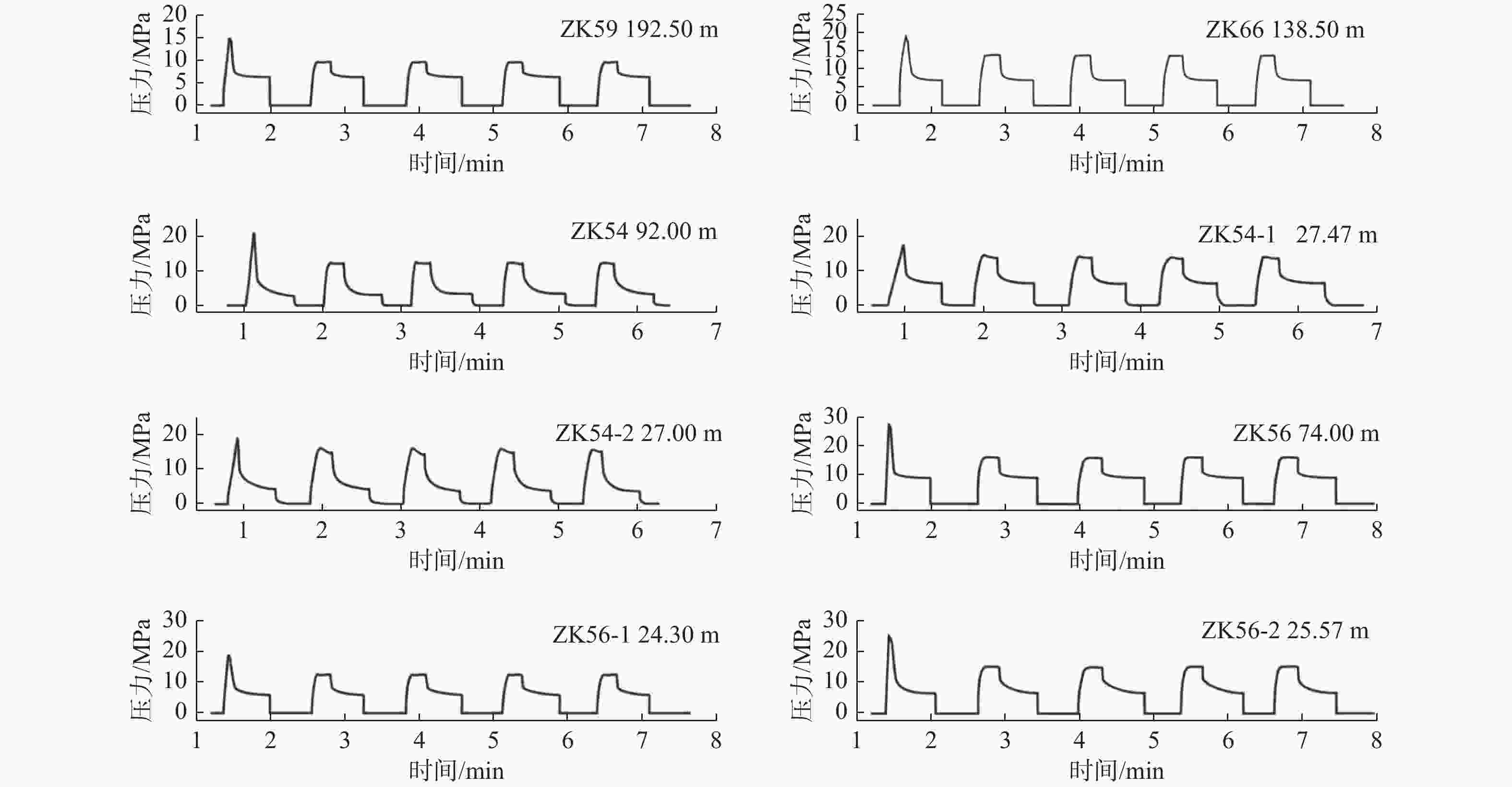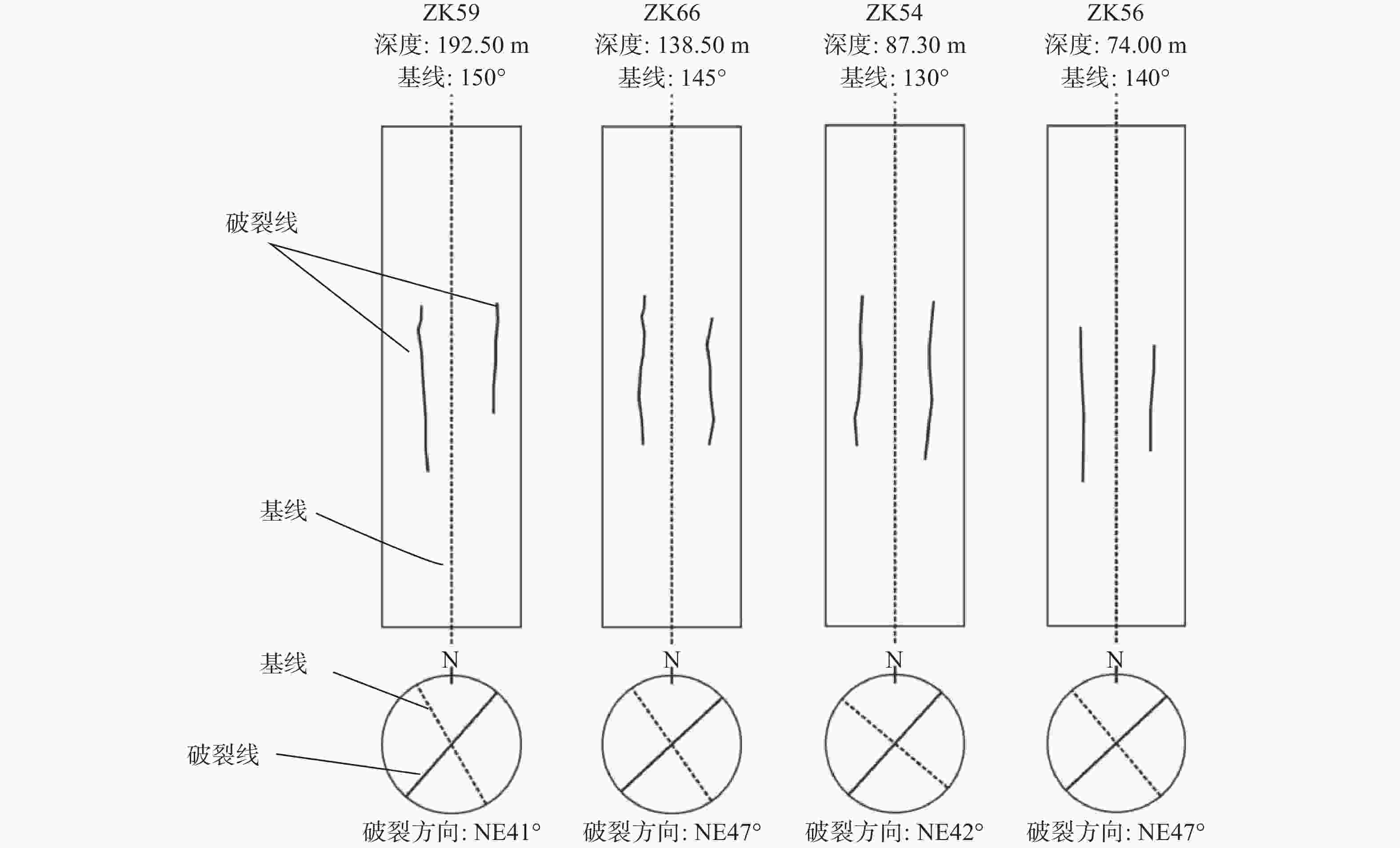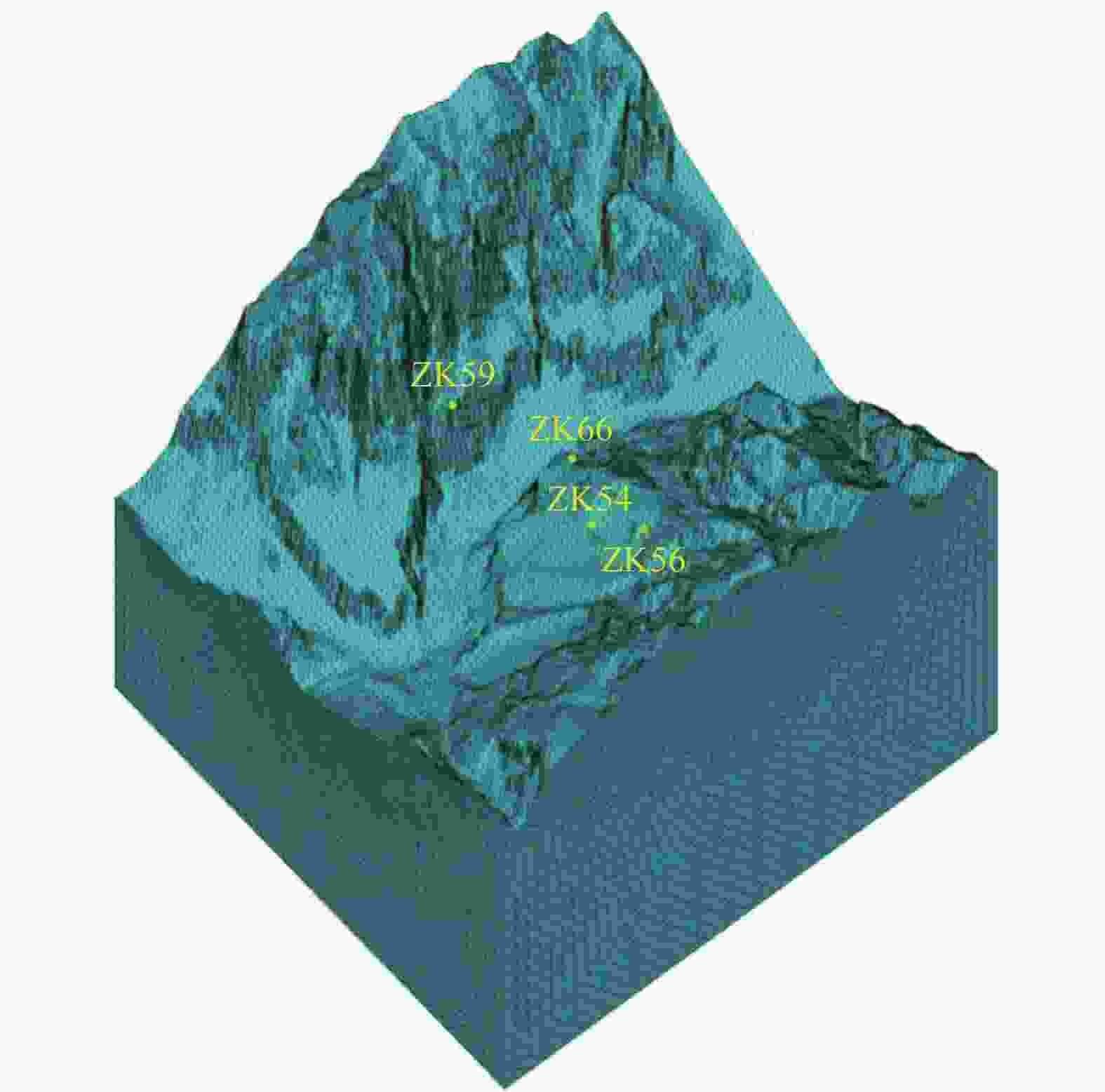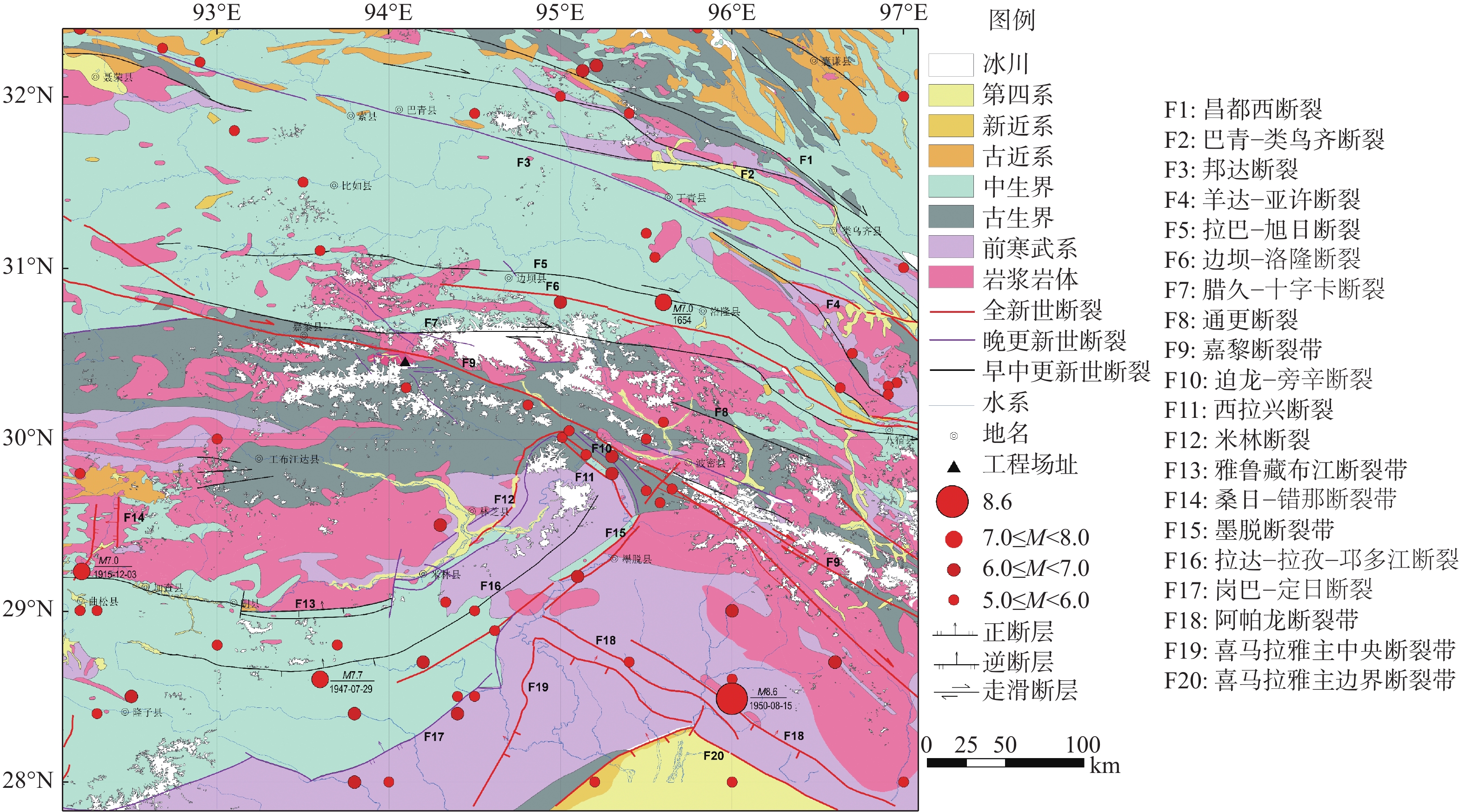In-situ stress measurement and inversion analysis of a large hydropower project in southeast Tibet
-
摘要:
某水电站作为西藏易贡藏布流域的控制性调节工程,对满足西藏电网的用电需求发挥重要作用。为查明该水电站现今地应力环境,掌握地下厂房、引水隧洞等关键位置地应力分布特征,保障其工程安全,文章综合考虑工程区构造地质背景、岩体条件等,通过布设钻孔开展水压致裂法地应力测量工作,获得4个测点(8个孔)的地应力数据;依据现有地质条件,建立有限元三维地质模型;通过测得的应力状态,获得加载条件,进行工程区应力场反演分析。结果表明:二维地应力测试结果显示最大水平主应力为4.17~16.93 MPa,三维地应力测试结果显示最大主应力为14.20~16.23 MPa,最大水平主应力方位为NE 38°~NE 47°,现今构造应力场以北东向为主导;电站地下厂房区域2995 m高程水平面最大主应力σ1应力值为11.70~12.12 MPa,中间主应力σ2应力值为9.81~10.74 MPa,最小主应力σ3应力值为5.22~6.85 MPa;引水隧洞沿线最大主应力值σ1为11.8~14.05 MPa,中间主应力值σ2为10.13~12.83 MPa,最小主应力值σ3为4.56~8.49 MPa;该水电站地下厂房轴线方向和引水隧洞轴线方向与实测最大主应力方向呈小角度相交,地应力场对工程洞室的稳定性有利。后期施工过程中应综合考虑实际地质情况,采用适宜的隧洞施工技术并加强施工监测,从而确保工程安全建设。
Abstract:As a control and regulating project, the hydropower station in the Yigongzangbu basin of Tibet plays a vital role in meeting the electricity demand of the Tibetan power grid. Identifying this hydropower station’s present-day in-situ stress environment and understanding the characteristics of in-situ stress distribution at critical locations such as underground plants and diversion tunnels are essential to ensure its engineering safety. Based on the tectonic and geological background and rock conditions of the project area, we carried out hydraulic fracturing in-situ stress measurements by placing boreholes and obtained in-situ stress data from 4 measurement points (8 boreholes). A finite element three-dimensional geological model was established according to the existing geological conditions. The measured stress state revealed the loading conditions, and the inverse analysis of the stress field in the engineering area was made. The maximum horizontal principal stress ranges from 4.17 to 16.93 MPa in the 2D test and 14.2 to 16.23 MPa in the 3D test. The maximum horizontal principal stress orientation is NE 38°to NE 47°, and the NE direction dominates the present-day tectonic stress field. In the 2995-meter elevation horizontal plane of the underground plant area of the power station, the stress values of σ1, σ2, and σ3 range from 11.70 to 12.12 MPa, 9.81 to 10.74 MPa, and 5.22 to 6.85 MPa, respectively. The maximum principal stress value of σ1, σ2, and σ3 along the diversion tunnel range from 11.8 to 14.05 MPa, 10.13 to 12.83 MPa, and 4.56 to 8.49 MPa, respectively. The axis direction of this hydropower station’s underground plant and the diversion tunnel’s axis direction intersect at a slight angle with the direction of the measured maximum principal stress, and the ground stress field is favorable to the stability of the project cavern. It is necessary to consider the actual geological conditions and adopt suitable tunnel construction technology in the later construction process. The construction monitoring should also be strengthened to ensure the project’s safe construction.
-
表 1 测试钻孔基本信息
Table 1. Basic parameters of the test boreholes
测点编号 孔号 钻孔方位角/(°) 钻孔倾角/ (°) 孔口高程(埋深)/m 孔深(水位)/m ST-1 ZK59 / 90 3139.1(214.0) 200.8(78.4) ST-2 ZK66 / 90 3100.0(112.0) 151.6(100.3) ST-3 ZK54 / 90 3022.5(334.5) 101.0(0) ZK54-1 58 −3 30.8(/) ZK54-2 168 −3 31.0(/) ST-4 ZK56 / 90 3022.5(442.5) 80.8(0) ZK56-1 17 −3 30.8(/) ZK56-2 119 −3 30.7(/) 表 2 各测点压裂试验测试深度
Table 2. Depth of each measuring point for fracturing test
测点编号 孔号 有效数据/段 测试深度/m ST-1 ZK59 6 31.00、56.00、81.00、132.00、155.00、192.50 ST-2 ZK66 5 49.00、82.50、101.00、119.40、138.50 ST-3 ZK54 5 12.90、37.00、61.50、87.30、92.00 ZK54-1 5 10.50、14.50、20.40、24.30、27.50 ZK54-2 6 6.84、11.70、14.80、18.36、24.06、27.00 ST-4 ZK56 4 36.50、50.50、64.54、74.00 ZK56-1 3 14.90、20.40、24.30 ZK56-2 4 10.70、17.80、24.30、25.57 表 3 ST-1、ST-2二维地应力测试结果
Table 3. The results of two dimensional in-situ stress measurement (ST-1&ST-2)
测点
编号钻孔
编号深度H/m 压裂特征参数/MPa 主应力值/MPa SH方位 破裂压力Pb 重张压力Pr 关闭压力Ps SH Sh Sv ST-1 ZK59 31.00 9.32 3.92 2.49 4.17 2.80 6.47 56.00 8.94 4.41 3.14 6.13 3.70 7.13 81.00 9.37 5.89 4.04 7.82 4.85 7.79 NE38° 132.00 13.42 8.26 6.32 12.80 7.64 9.14 NE45° 155.00 14.03 8.58 6.63 13.64 8.18 9.75 192.50 15.01 9.55 7.45 15.51 9.38 10.75 NE41° ST-2 ZK66 49.00 21.80 12.17 7.49 11.28 7.98 4.27 82.50 16.57 12.11 8.24 14.26 9.07 5.15 NE39° 101.00 15.51 9.07 7.32 14.90 8.33 5.64 NE43° 119.40 17.93 12.91 9.06 16.47 10.25 6.13 138.50 18.76 13.57 9.37 16.93 10.76 6.64 NE47° 表 4 ST-3、ST-4三维地应力测试计算结果
Table 4. The results of three dimensional in-situ stress measurement (ST-3&ST-4)
测点
编号埋深/m 最大主应力σ1 中间主应力σ2 最小主应力σ3 量值/MPa 方位角/(°) 仰角/(°) 量值/MPa 方位角/(°) 仰角/(°) 量值/MPa 方位角/(°) 仰角/(°) ST-3 334.5 14.20 235.4 −18.2 12.56 152.5 19.6 9.07 106.0 −62.0 ST-4 441.5 16.23 248.0 −22.8 14.28 167.0 20.0 7.68 114.0 −58.0 表 5 地应力实测数据与反演值对比表
Table 5. Comparison of in-situ stress data and inversion data
测点
编号序号 深度/m SH/MPa Sh/MPa Sv/MPa 实测 反演值 实测 反演值 实测 反演值 ST-1 1 31.00 4.17 15.11 2.80 2.45 6.48 9.21 2 56.00 6.13 15.53 3.70 3.84 7.14 9.86 3 81.00 7.82 14.72 4.85 4.95 7.80 10.36 4 132.00 12.80 15.44 7.64 6.93 9.15 11.08 5 155.00 13.64 15.30 8.18 7.59 9.76 11.32 6 192.50 15.51 15.15 9.38 8.84 10.76 11.79 ST-2 7 49.00 11.28 11.86 7.98 7.54 4.31 2.02 8 82.50 14.26 14.11 9.07 9.34 5.19 3.45 9 101.00 14.90 14.93 8.33 10.25 5.68 4.59 10 119.40 16.47 15.22 10.25 10.94 6.17 5.83 11 138.50 16.93 15.10 10.76 11.29 6.68 6.57 ST-3 12 12.90 8.27 11.56 5.36 5.28 9.18 9.89 13 37.00 10.07 12.07 6.51 6.09 9.82 10.47 14 61.50 13.11 12.43 8.20 6.76 10.47 10.91 15 87.30 13.73 12.81 8.50 7.50 11.15 11.38 16 92.00 13.70 12.88 9.23 7.69 11.28 11.49 ST-4 17 36.50 13.97 11.90 9.63 7.10 12.72 10.84 18 50.50 17.38 12.10 11.24 7.40 13.09 11.04 19 64.54 14.11 12.33 10.34 7.74 13.46 11.28 20 74.00 17.74 12.49 11.79 7.99 13.71 11.44 -
[1] CAI H C, WANG W T, DUAN L, et al. , 2022. Paleomagnetic evidence of Cenozoic tectonic deformation in Lulehe area, Qaidam basin, northeastern margin of Tibet Plateau[J]. Acta Geologica Sinica, 96(10): 3345-3359. (in Chinese with English abstract) [2] CHENG W R, ZHANG W C, LIU Y, 2021. Inversion of in-situ stress field in underground powerhouse area of a hydropower station[J]. Journal of Jilin Jianzhu University, 38(6): 12-18. (in Chinese with English abstract) [3] ENGLAND P, MOLNAR P, 1997. Active deformation of Asia: from kinematics to dynamics[J]. Science, 278(5338): 647-650. doi: 10.1126/science.278.5338.647 [4] FAN Q X, LIN P, JIANG S, et al. , 2020. Review on the rock mechanics and engineering practice for large hydropower stations along the downstream section of the Jinsha River[J]. Journal of Tsinghua University (Science and Technology), 60(7): 537-556. (in Chinese with English abstract) [5] FENG C J, LI B, LI H, et al. , 2022. Estimation of in-situ stress field surrounding the Namcha Barwa region and discussion on the tectonic stability[J]. Journal of Geomechanics, 28(6): 919-937. (in Chinese with English abstract) [6] FU C H, WANG W M, CHEN S H, 2006. Back analysis study on initial geostress field of dam site for XILUODU hydropower project[J]. Chinese Journal of Rock Mechanics and Engineering, 25(11): 2305-2312. (in Chinese with English abstract) [7] HAIMSON B C, CORNET F H, 2003. ISRM suggested methods for rock stress estimation-part 3: Hydraulic Fracturing (HF) and/or Hydraulic Testing of Pre-existing Fractures (HTPF)[J]. International Journal of Rock Mechanics and Mining Sciences, 40(7-8): 1011-1020. doi: 10.1016/j.ijrmms.2003.08.002 [8] HAN B, XIAO Q, DING X C, et al. , 2022. Study on the initial geostress distribution law of surrounding rock of underground cavern of Jinchuan hydropower station[J]. Northwest Water Power(2): 67-70. (in Chinese with English abstract) [9] HARRISON T M, COPELAND P, KIDD W S F, et al. , 1992. Raising Tibet[J]. Science, 255(5052): 1663-1670. doi: 10.1126/science.255.5052.1663 [10] HOU J, WU Z, LIU N, et al. , 2019. Research on key technical problems of hydropower design in high-altitude deep gorge area of Tibet[J]. Water Power, 45(2): 14-17, 38. (in Chinese with English abstract) [11] KIM K, FRANKLIN J A, 1988. ISRM: Suggested methods for rock stress determination[J]. ZHANG S T, trans. Chinese Journal Rock Mechanics and Engineering, 7(4): 357-388. (in Chinese) [12] LEE S G, 1973. Introduction to geomechanics[M]. Beijing: Science and Technology Press. (in Chinese) [13] LI B, YIN Y P, TAN C X, et al. , 2022. Geo-safety challenges against the site selection of engineering projects in the eastern Himalayan syntaxis area[J]. Journal of Geomechanics, 28(6): 907-918. (in Chinese with English abstract) [14] LIU Y F, 2000. Geostress and engineering construction[M]. Wuhan: Hubei Science and Technology Press. (in Chinese) [15] LIU Y F, ZHONG Z W, WANG J, 2002. Interpretation of 3-dimensional geostress results measured by hydraulic fracturing technique[J]. Chinese Journal of Rock Mechanics and Engineering, 21(6): 833-838. (in Chinese with English abstract) [16] MENG W, TIAN T, SUN D S, et al. , 2022. Research on stress state in deep shale reservoirs based on in-situ stress measurement and rheological model[J]. Journal of Geomechanics, 28(4): 537-549. (in Chinese with English abstract) [17] MOLNAR P, ENGLAND P, MARTINOD J, 1993. Mantle dynamics, uplift of the Tibetan Plateau, and the Indian monsoon[J]. Reviews of Geophysics, 31(4): 357-396. doi: 10.1029/93RG02030 [18] QUAN H, 2017. Application of 3-dimensional hydraulic fracturing method to in-situ stress measurement in hydropower engineering[J]. Sichuan Water Power, 36(1): 75-80. (in Chinese) [19] REN Y Q, TANG B L, CHEN X M, et al. , 2021. Inversion analysis of the Three dimension Geostress field in a tunnel[J]. IOP Conference Series: Earth and Environmental Science, 643(1): 012047. doi: 10.1088/1755-1315/643/1/012047 [20] ROYDEN L H, BURCHFIEL B C, KING R W, et al. , 1997. Surface deformation and lower crustal flow in eastern Tibet[J]. Science, 276(5313): 788-790. doi: 10.1126/science.276.5313.788 [21] SUN Y, TAN C X, LI K S, et al. , 1998. Quantitative assessment and research of regional crustal stability[M]. Beijing: Geology Press. (in Chinese) [22] TAN C X, SUN W F, SUN Y, et al. , 2006. A consideration on in-situ crustal stress measuring and its underground engineering application[J]. Acta Geologica Sinica, 80(10): 1627-1632. (in Chinese with English abstract) [23] TAPPONNIER P, XU Z Q, ROGER F, et al. , 2001. Oblique stepwise rise and growth of the Tibet Plateau[J]. Science, 294(5547): 1671-1677. doi: 10.1126/science.105978 [24] WANG E Q, BURCHFIEL B C, JI J Q, 2001. Calculation of the Cenozoic crustal shortening in eastern Himalayan syntaxis and its geological evidences[J]. Science in China (Series D), 31(1): 1-9. (in Chinese with English abstract) [25] WANG X G, WANG J D, HOU T S, et al. , 2016. Geostress test and analysis of the Tibet Bangpu mining area[J]. International Journal of Geotechnical Engineering, 11(2): 156-162. [26] XIAO B Z, 2008. Measurement and study of geo-stresses for underground plant Area of Yantan hydropower station[J]. Journal of Yangtze River Scientific Research Institute, 25(1): 65-69. (in Chinese with English abstract) [27] XIAO L, LUO S W, CHEN R H, et al. , 2019. Three-dimensional simulation inverse analysis of initial Geostress field of a hydropower station[J]. Northwest Hydropower(5): 86-89. (in Chinese with English abstract) [28] XIE F R, CHEN Q C, CUI X F, et al. , 2007. Fundamental database of crustal stress environment in continental China[J]. Progress in Geophysics, 22(1): 131-136. (in Chinese with English abstract) [29] XIE H Q, XIAO M L, HE J D, et al. , 2008. Regression analysis of initial Geostress for dam region of Jinping hydropower station[J]. Journal of Yangtze River Scientific Research Institute, 25(5): 50-54. (in Chinese with English abstract) [30] YUAN F B, LIU J, LI P J, et al. , 2007. Back analysis and multiple-factor influencing mechanism of high geostress field for river valley region of Laxiwa hydropower engineering[J]. Rock and Soil Mechanics, 28(4): 836-842. (in Chinese with English abstract) [31] ZHANG P, QU Y M, GUO C B, et al. , 2017a. Analysis of in-situ stress measurement and real-time monitoring results in Nyching of Tibetan Plateau and its response to Nepal MS8.1 earthquake[J]. Geoscience, 31(5): 900-910. (in Chinese with English abstract) [32] ZHANG P, SUN Z G, WANG Q N, et al. , 2017b. In-situ stress measurement and stability analysis of surrounding rocks in the north section of deep buried tunnel in Muzhailing[J]. Journal of Geomechanics, 23(6): 893-903. (in Chinese with English abstract) [33] ZHANG Y X, SONG C S, CAI M F, et al. , 2010. Geostress measurements by hydraulic fracturing method at great depth of boreholes and numerical modelling predictions of stress field[J]. Chinese Journal of Rock Mechanics and Engineering, 29(4): 778-786. (in Chinese with English abstract) [34] ZHOU Y, LI Q C, PAN B, et al. , 2018. Back analysis of initial geostress field in deep-cut valley of Yangfanggou hydropower station[J]. Yangtze River, 49(24): 44-48, 71. (in Chinese with English abstract) [35] ZOBACK M D, HEALY J H, 1992. In situ stress measurements to 3.5 km depth in the Cajon Pass scientific research borehole: Implications for the mechanics of crustal faulting[J]. Journal of Geophysical Research: Solid Earth, 97(B4): 5039-5057. doi: 10.1029/91JB02175 [36] 蔡火灿, 王伟涛, 段磊, 等, 2022. 青藏高原东北缘柴达木盆地路乐河地区新生代构造变形的古地磁证据[J]. 地质学报, 96(10): 3345-3359. [37] 程王润, 张文春, 刘英, 2021. 某水电站地下厂房区地应力场反演[J]. 吉林建筑大学学报, 38(6): 12-18. [38] 樊启祥, 林鹏, 蒋树, 等, 2020. 金沙江下游大型水电站岩石力学与工程综述[J]. 清华大学学报(自然科学版), 60(7): 537-556. [39] 丰成君, 李滨, 李惠, 等, 2022. 南迦巴瓦地区地应力场估算与构造稳定性探讨[J]. 地质力学学报, 28(6): 919-937. [40] 付成华, 汪卫明, 陈胜宏, 2006. 溪洛渡水电站坝区初始地应力场反演分析研究[J]. 岩石力学与工程学报, 25(11): 2305-2312. [41] 韩斌, 肖清, 丁新潮, 等, 2022. 金川水电站地下洞室围岩初始地应力分布规律研究[J]. 西北水电(2): 67-70. [42] 侯靖, 吴忠, 刘宁, 等, 2019. 西藏高海拔深切峡谷地区水电设计关键技术问题研究[J]. 水力发电, 45(2): 14-17, 38. [43] 基姆, 弗兰克林, 1988. 国际岩石力学学会试验方法委员会确定岩石应力的建议方法[J]. 张受天, 译. 岩石力学与工程学报, 7(4): 357-388. [44] 李滨, 殷跃平, 谭成轩, 等, 2022. 喜马拉雅东构造结工程选址面临的地质安全挑战[J]. 地质力学学报, 28(6): 907-918. [45] 李四光, 1973. 地质力学概论[M]. 北京: 科学出版社. [46] 刘允芳, 2000. 岩体地应力与工程建设[M]. 武汉: 湖北科学技术出版社. [47] 刘允芳, 钟作武, 汪洁, 2002. 水压致裂法三维地应力测量成果计算与分析的探讨[J]. 岩石力学与工程学报, 21(6): 833-838. [48] 孟文, 田涛, 孙东生, 等, 2022. 基于原位地应力测试及流变模型的深部泥页岩储层地应力状态研究[J]. 地质力学学报, 28(4): 537-549. [49] 全海, 2017. 三维水压致裂法地应力测试在水电工程中的应用[J]. 四川水力发电, 36(1): 75-80. [50] 孙叶, 谭成轩, 李开善, 等, 1998. 区域地壳稳定性定量化评价[M]. 北京: 地质出版社. [51] 谭成轩, 孙炜锋, 孙叶, 等, 2006. 地应力测量及其地下工程应用的思考[J]. 地质学报, 80(10): 1627-1632. [52] 王二七, BURCHFIEL B C, 季建清, 2001. 东喜马拉雅构造结新生代地壳缩短量的估算及其地质依据[J]. 中国科学(D辑), 31(1): 1-9. [53] 肖本职, 2008. 广西岩滩水电站地下厂房区地应力测试与分析[J]. 长江科学院院报, 25(1): 65-69. [54] 肖蕾, 骆世威, 陈仁宏, 等, 2019. 某水电站初始地应力场三维模拟反演分析[J]. 西北水电(5): 86-89. [55] 谢富仁, 陈群策, 崔效锋, 等, 2007. 中国大陆地壳应力环境基础数据库[J]. 地球物理学进展, 22(1): 131-136. [56] 谢红强, 肖明砾, 何江达, 等, 2008. 锦屏水电站坝区初始地应力场回归反演分析[J]. 长江科学院院报, 25(5): 50-54. [57] 袁风波, 刘建, 李蒲健, 等, 2007. 拉西瓦工程河谷区高地应力场反演与形成机理[J]. 岩土力学, 28(4): 836-842. [58] 张鹏, 曲亚明, 郭长宝, 等, 2017a. 西藏林芝地应力测量监测与尼泊尔MS8.1级强震远场响应分析[J]. 现代地质, 31(5): 900-910. [59] 张鹏, 孙治国, 王秋宁, 等, 2017b. 木寨岭深埋隧道北段地应力测量与围岩稳定性分析[J]. 地质力学学报, 23(6): 893-903. [60] 张延新, 宋常胜, 蔡美峰, 等, 2010. 深孔水压致裂地应力测量及应力场反演分析[J]. 岩石力学与工程学报, 29(4): 778-786. [61] 周勇, 李啟常, 潘兵, 等, 2018. 杨房沟水电站深切河谷地应力场反演分析[J]. 人民长江, 49(24): 44-48, 71. -





 下载:
下载:








